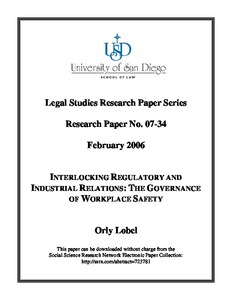Interlocking regulatory and industrial relations: the governance of workplace safety
"Pressures to redesign public policies in ways that account for more flexibility, responsiveness, and private participation present an opportunity to revisit law's traditional emphasis on adversarialism. Rather than aligning legality with conflict and informality with cooperation, a new co...
| Main Author: | |
|---|---|
| Institution: | ETUI-European Trade Union Institute |
| Format: | TEXT |
| Language: | English |
| Published: |
San Diego
2005
University of San Diego. School of Law |
| Subjects: | |
| Online Access: | https://www.labourline.org/KENTIKA-19133781124919519639-interlocking-regulatory-and-in.htm |
| Summary: | "Pressures to redesign public policies in ways that account for more flexibility, responsiveness, and private participation present an opportunity to revisit law's traditional emphasis on adversarialism. Rather than aligning legality with conflict and informality with cooperation, a new concept of administrative governance expands the framework of the legal process. In the context of workplace regulation, new governance structures must reflect the conditions of the new economy and the relationships between employers and workers. Studying the field of occupational safety, the article advances three arguments. First, the introduction of third-way governance-based approaches, including regulatory requirements on internal safety planning and worker participation at the individual firm-level, complementing regulatory and market approaches, is necessary for occupational risk prevention. Second, normative and methodological principles can be developed to evaluate the consequences and legitimacy of shifts away from the command-and-control approach to occupational safety, and in particular, to distinguish new governance approaches from deregulation. Third, the article argues that central doctrines of administrative procedure and labor law have served as impediments for diversifying state action in regulating the new labor market. In particular, two key reforms - combining targeted enforcement with a cooperative choice and mandating employee safety committees - were abandoned following legal disputes and the use of categories which rely on an adversarial understanding of legal action. A set of understandings, embedded in legal doctrine from former eras, continues to impede the shift to a more comprehensive, effective, and legitimate worker safety regime. The distinction in the Administrative Procedure Act (APA) between substantive rule-making and procedural policy-making and the distinction of the National Labor Relations Act (NLRA) between bargainable issues and managerial prerogatives have limited the legal reach of workplace governance. Both policy areas are based on concepts of hierarchy, autonomy, control, conflict, and adversarial one-shot interactions." |
|---|---|
| Physical Description: | 87 p. Digital |

